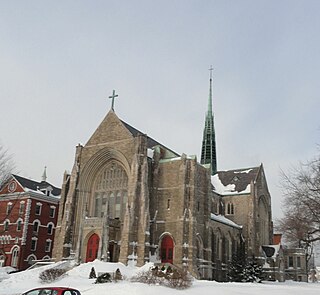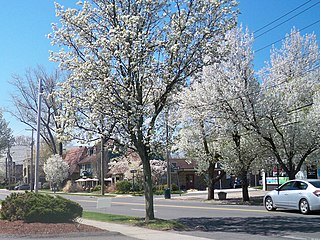
New Haven County is a county in the south central part of the U.S. state of Connecticut. As of the 2020 census, the population was 864,835, making it the third-most populous county in Connecticut. Two of the state's largest cities, New Haven (3rd) and Waterbury (5th), are part of New Haven County.

The New Haven Colony was a small English colony in North America from 1637 to 1664 primarily in parts of what is now the state of Connecticut, but also with outposts in modern-day New York, New Jersey, Pennsylvania, and Delaware.

The Connecticut Yankee Council of the Boy Scouts of America is located in Milford, Connecticut. It is council #072 and serves 37 towns and cities in Connecticut, located in Fairfield County, New Haven County, and parts of Hartford County. The present council was formed in 1998 by the merger of Quinnipiac Council (#074) and Fairfield County Council (#068).Owaneco Lodge is the Order of the Arrow lodge that serves this council.

Area codes 203 and 475 are the North American telephone area codes that are assigned to the southwestern part of Connecticut. It includes most of Fairfield County, all of New Haven County, and a small portion of Litchfield County. The region encompassed by 203 and 475 is mostly coextensive with the Connecticut portion of the New York metropolitan area.

The Archdiocese of Hartford is a Latin Church ecclesiastical territory or archdiocese of the Catholic Church in Hartford, Litchfield and New Haven counties in the U.S. State of Connecticut. The archdiocese includes about 470,000 Catholics, more than 500 priests, 216 parishes and almost 300 deacons. This is roughly one-half the population of the three counties. The Archdiocese of Hartford is a metropolitan see.
Maurice Francis McAuliffe was an American clergyman of the Catholic Church. He served as Bishop of Hartford from 1934 until his death in 1944.

Timothy G. O’Connell (1868–1955) was an American architect whose Boston-based practice specialized in ecclesiastical design.

Anthony J. DePace (1892–1977) was an American architect who designed numerous Roman Catholic churches throughout the Northeastern United States area during the mid to late 20th century.

Gustave E. Steinback (1878–1959) was an American architect practicing in New York City in the early and mid twentieth century. He was particularly known as a designer of Roman Catholic schools and churches. His offices were located at 157 West 74th Street in the 1920s, and in Stamford, Connecticut in the 1940s.

Joseph A. Jackson (1861–1940) was an American architect who designed many buildings for Roman Catholic clients in the Eastern United States, especially Connecticut.

Henry F. Ludorf (1888–1968) was an American architect who specialized in churches and schools mostly for Polish-American Catholic clients in New England.

St Maurice is a Roman Catholic church in Stamford, Connecticut, part of the Diocese of Bridgeport.

St. Theresa Church is a Roman Catholic church in Trumbull, Connecticut, a part of the Diocese of Bridgeport. The parish is considered the Mother Church of Trumbull and is the largest in town with over 3,100 parishioner families.
St. Thomas Aquinas is a Roman Catholic church in Fairfield, Connecticut, in the Diocese of Bridgeport. The present Colonial-style church was designed by Polak and Sullivan of New Haven, CT.

J. Gerald Phelan was a U.S. architect and corporate executive who was very active throughout the Eastern part of the United States throughout the middle part of the 20th century.

John J. McMahon was an American architect who even today remains highly regarded for his churches, schools and other buildings for Catholic clients in Connecticut, especially Hartford and New Haven.

Spring Glen is a neighborhood in the southeastern portion of the town of Hamden, Connecticut. It is primarily residential, mostly single-family homes with a few two-family. Commercial development is entirely on its principal street, Whitney Avenue. It was developed throughout the first half of the twentieth century as a trolley suburb of New Haven. It was named for the Spring Glen dairy farm established by James J. Webb in 1858 in what would become part of the neighborhood.















